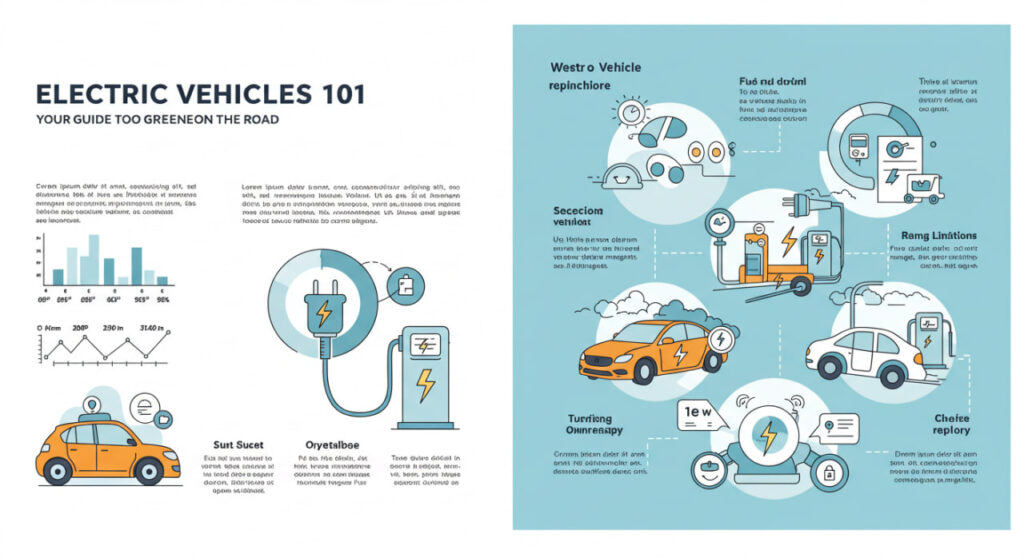Electric vehicles (EVs) are transforming the way we drive, offering a cleaner, more sustainable alternative to traditional gas-powered cars. With advancements in battery technology, growing charging infrastructure, and increasing environmental awareness, EVs are no longer a niche choice—they’re becoming mainstream. Whether you’re curious about how EVs work, their benefits, or what it’s like to own one, this guide breaks down everything you need to know to hit the road with confidence. Let’s dive into the world of electric vehicles and explore why going green is more exciting than ever.
What Are Electric Vehicles and How Do They Work?
The Basics of EV Technology
Electric vehicles run on electricity stored in high-capacity batteries, powering an electric motor to drive the wheels. Unlike internal combustion engine (ICE) vehicles that burn gasoline or diesel, EVs produce zero tailpipe emissions, making them a cornerstone of eco-friendly transportation. The heart of an EV is its battery pack, typically lithium-ion, which stores energy and delivers it to the motor. When you press the accelerator, the motor converts electrical energy into mechanical power, propelling the vehicle smoothly and quietly.
EVs also feature regenerative braking, a clever system that captures energy during braking and feeds it back into the battery, boosting efficiency. Most EVs come with onboard chargers that convert alternating current (AC) from charging stations into direct current (DC) to store in the battery. With ranges now exceeding 300 miles on many models, EVs are practical for daily commutes and long-distance trips alike.
Types of Electric Vehicles
Not all EVs are created equal. There are three main types to consider:
- Battery Electric Vehicles (BEVs): These run entirely on electricity, with no gas engine. Examples include the Tesla Model 3 and Nissan Leaf. BEVs offer the lowest operating costs and zero emissions but rely on charging infrastructure.
- Plug-in Hybrid Electric Vehicles (PHEVs): These combine a battery-powered electric motor with a gas engine. PHEVs, like the Toyota Prius Prime, can run on electricity for shorter trips (typically 20–50 miles) before switching to gas, offering flexibility for those not ready to go fully electric.
- Hybrid Electric Vehicles (HEVs): While not true EVs, HEVs like the standard Toyota Prius use a combination of a gas engine and a small battery to improve fuel efficiency. They don’t plug in, so they’re less relevant for those seeking a fully electric experience.
Each type suits different lifestyles, so understanding your driving habits is key to choosing the right one.
Why Choose an Electric Vehicle?
Environmental Benefits
The most compelling reason to go electric is the environmental impact. EVs produce zero tailpipe emissions, significantly reducing your carbon footprint. According to the U.S. Environmental Protection Agency (EPA), transportation accounts for nearly 30% of greenhouse gas emissions in the U.S., with passenger vehicles being a major contributor. By switching to an EV, you’re helping combat climate change and reduce air pollution, especially in urban areas where smog is a concern. Plus, as the grid becomes greener with renewable energy sources like solar and wind, the environmental benefits of EVs only increase.
Cost Savings Over Time
While EVs often have a higher upfront cost than gas-powered cars, the long-term savings are substantial. Electricity is cheaper than gasoline—on average, charging an EV costs the equivalent of $1–$2 per gallon of gas, depending on local rates. Maintenance is also less expensive since EVs have fewer moving parts. There’s no need for oil changes, spark plugs, or exhaust system repairs. Federal and state incentives, such as tax credits up to $7,500 in the U.S., can further offset the purchase price, making EVs more affordable than ever.
Driving Experience
EVs aren’t just good for the planet—they’re a blast to drive. Electric motors deliver instant torque, providing quick acceleration that rivals many sports cars. The low center of gravity, thanks to the battery pack, ensures excellent handling and stability. Plus, EVs are remarkably quiet, creating a serene driving experience without the rumble of a gas engine. Features like one-pedal driving, where lifting off the accelerator slows the car via regenerative braking, add a unique and intuitive feel to the ride.
Key Considerations Before Buying an EV
Range and Charging Infrastructure
Range anxiety—the fear of running out of battery power—is a common concern for new EV buyers. However, modern EVs like the Tesla Model S or Lucid Air offer ranges exceeding 400 miles, while more affordable models like the Hyundai Kona Electric provide 250–300 miles. To ease range concerns, plan your charging strategy. Home charging with a Level 2 charger (240V) is the most convenient, offering 20–40 miles of range per hour of charging. Public charging networks, like Tesla’s Supercharger or Electrify America, are expanding rapidly, with fast chargers delivering 100–200 miles of range in 20–30 minutes.
Before buying, check the charging infrastructure in your area. Apps like PlugShare or ChargePoint can help locate stations, and many EVs come with navigation systems that plan routes with charging stops. If you live in an apartment or lack home charging, ensure public chargers are accessible nearby.
Battery Life and Maintenance
EV batteries are designed to last. Most manufacturers offer warranties of 8–10 years or 100,000–150,000 miles, and studies show batteries retain 80–90% of their capacity after a decade. To maximize battery life, avoid frequent fast charging and keep the battery between 20–80% charge when possible. Maintenance is minimal, but tires and brakes may need regular checks due to the vehicle’s weight and regenerative braking system.
Upfront Costs and Incentives
The sticker price of EVs can be daunting, with popular models ranging from $30,000 for a Nissan Leaf to over $80,000 for a Tesla Model X. However, incentives can make a big difference. In the U.S., the federal EV tax credit applies to many models, and states like California and Colorado offer additional rebates. Leasing is another option, allowing you to enjoy an EV without committing to a long-term purchase while taking advantage of lower monthly payments.
Top Electric Vehicles to Consider in 2025
Tesla Model 3: The Benchmark
The Tesla Model 3 remains a top choice for its blend of performance, range, and technology. With a range of up to 353 miles (Performance variant) and access to Tesla’s extensive Supercharger network, it’s ideal for both city and highway driving. The minimalist interior, dominated by a 15-inch touchscreen, offers a futuristic feel, though it may take time to adjust to the lack of physical buttons. Starting at around $40,000 after incentives, it’s a compelling option for first-time EV buyers.
Ford Mustang Mach-E: The Fun Factor
The Ford Mustang Mach-E combines SUV practicality with sporty performance. Its 300-mile range (Extended Range model) and agile handling make it a joy to drive, while the spacious interior and user-friendly tech appeal to families. Ford’s BlueCruise hands-free driving system adds a layer of convenience for highway trips. Priced from $43,000, it’s a versatile choice for those wanting style and substance.

Hyundai Ioniq 5: The Retro-Futuristic Choice
The Hyundai Ioniq 5 stands out with its bold, retro-inspired design and impressive tech. Offering up to 303 miles of range and ultra-fast charging (up to 80% in 18 minutes), it’s perfect for those who value efficiency and aesthetics. The roomy cabin and smooth ride make it a great daily driver. Starting at $42,000, it’s a strong contender in the compact SUV segment.
The Future of Electric Vehicles
The EV market is evolving rapidly. By 2030, analysts predict EVs will account for 50% of new car sales globally, driven by stricter emissions regulations and falling battery costs. Innovations like solid-state batteries promise longer ranges and faster charging, while wireless charging and vehicle-to-grid technology could make EVs even more versatile. Automakers like Rivian, Lucid, and legacy brands like BMW and Mercedes are pushing the boundaries with luxury and performance models, ensuring there’s an EV for every taste and budget.
Governments are also stepping up, with initiatives like the U.S. Inflation Reduction Act boosting EV adoption through incentives and infrastructure investments. As charging networks expand and renewable energy grows, the case for going electric becomes stronger every year.
FAQ
How long does it take to charge an electric vehicle?
Charging times vary depending on the charger type. A Level 1 charger (120V, standard household outlet) can take 20–40 hours for a full charge. A Level 2 charger (240V) typically takes 4–8 hours, while DC fast chargers can deliver 80% charge in 20–30 minutes, depending on the vehicle and charger.
Are electric vehicles expensive to maintain?
No, EVs are generally cheaper to maintain than gas-powered cars. They have fewer moving parts, eliminating the need for oil changes, spark plugs, or exhaust system repairs. Routine maintenance includes tires, brakes, and occasional software updates.
Can I charge an EV at home?
Yes, most EV owners charge at home using a Level 1 or Level 2 charger. A Level 2 charger, which requires professional installation, is faster and more convenient. Ensure your home’s electrical system can support the charger, and check with your utility provider for off-peak charging rates to save money.
How far can an electric vehicle travel on a single charge?
Ranges vary by model, but most modern EVs offer 200–400 miles per charge. For example, the Tesla Model S Long Range can exceed 400 miles, while budget-friendly models like the Chevrolet Bolt EV offer around 259 miles. Check the EPA-estimated range when comparing vehicles.
Are there enough charging stations for long trips?
Charging infrastructure is growing rapidly. Networks like Tesla Supercharger, Electrify America, and ChargePoint offer thousands of stations across the U.S., with more added daily. Apps and in-car navigation systems help locate chargers, making long trips feasible with proper planning.




5dd35w
r3du4q